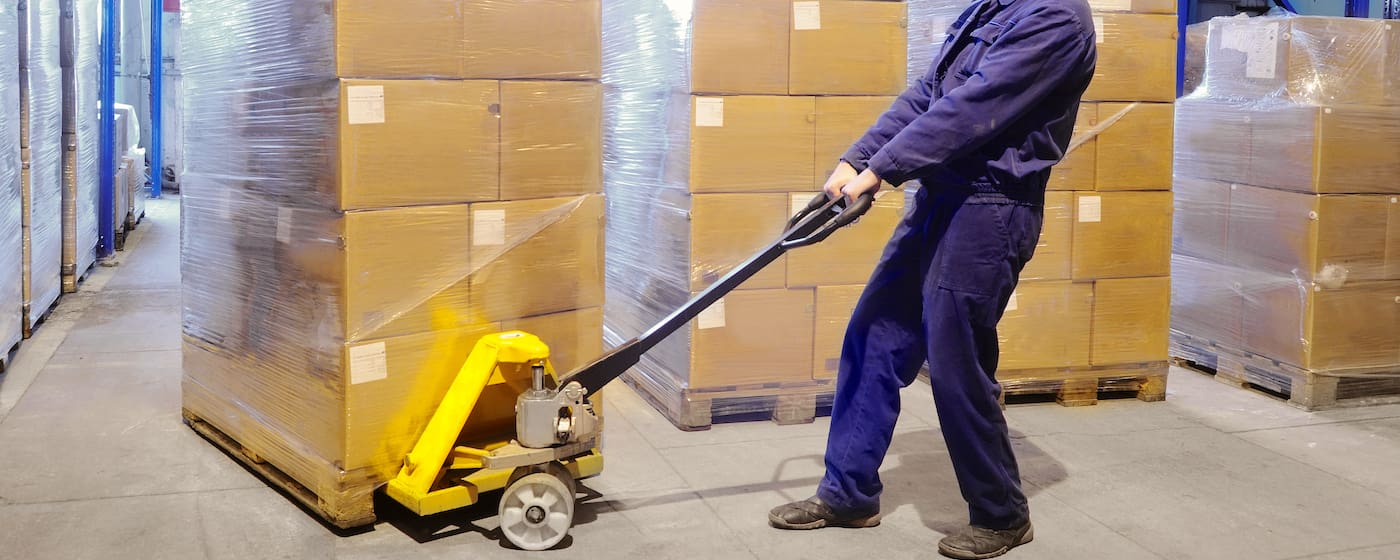Table of Contents
** Minutes
Step 1: Assess your current warehouse organization
Step 2: Define your warehouse organization goals
Step 3: Implement changes to optimize your organization
When a space is organized, it usually boosts productivity. An organized kitchen is easier to cook in, for example; an organized office minimizes distractions; an organized grocery store helps you find and purchase what you need quickly.
An ecommerce warehouse is no exception.
Warehouse organization goes hand-in-hand with good warehouse management. If your warehouse space is well-organized and your warehouse setup is optimized, it allows for more ease of movement and helps create a more efficient warehouse.
This, in turn, means that your staff can quickly complete their tasks and inventory can move seamlessly within the warehouse, which will increase your brand’s productivity and help you stay on track to hit your performance goals.
So how should an ecommerce brand go about organizing its warehouse space? In this post, we provide you with a detailed guide on the 3 steps that you can take to successfully optimize your warehouse organization.
Step 1: Assess your current warehouse organization
Warehouse organization refers to how items, workstations, and activities are laid out and physically positioned within a warehousing space.
Usually, a brand’s warehouse organization is extremely strategic, and designed to make the most of the available space while ensuring that workers can easily find items and perform functions quickly and safely.
However, many businesses struggle with their warehouse organization because they don’t know that their existing operations could be improved – or, if they do, they don’t know how to begin the optimization process.
Ideally, it’s best to start by assessing your current warehouse organization to look for any inefficiencies or problem areas.
For this first step, there are several aspects of your warehouse organization that you’ll need to review. Take the time to thoroughly assess each aspect and make a note of issues or potential improvements.
Cleanliness
In a cluttered workspace, it’s difficult to find what you need or move around easily, which can lead to inefficiencies. Not only that, but warehouse clutter sometimes poses a safety hazard, which may lead to accidents and injuries.
So, when evaluating your current warehouse organization, one of the first things you need to assess is how tidy your warehouse is and whether maintenance is done properly.
Make sure to take note of details to properly evaluate the tidiness and maintenance of your warehouse, such as:
- Old packages on the floor or taking up valuable space
- Unused equipment or pallets blocking aisle space
- Spills that are left uncleaned, which poses a safety hazard
- Cluttered workstations or messy floors that are difficult to navigate
- Trash or discarded materials that haven’t been properly disposed of
Safety
There may be some safety risks associated with how your warehouse is currently set up. For example, Shelves are overloaded with inventory, for example, could risk getting broken and causing inventory damage and accidents. Similarly, when you store heavy items higher up on the shelves, there’s a high risk that they’ll topple off and put your staff in danger.
If you’re going to optimize your warehouse organization, it’s crucial to carefully check for and identify any safety issues.
In addition to assessing your warehouse layout and storage systems for potential hazards, you should also review your warehouse safety protocols. Make sure you clearly specify where and how certain items should be stored or handled within the warehouse to avoid safety risks and liabilities.
For example, you should store hazardous chemicals away from other inventory and equipment and in cool, well-ventilated areas. They should be placed on sturdy shelves and be clearly marked with caution signs. Moreover, the warehouse staff handling those items should have access to appropriate PPE and any necessary safety equipment.
WMS
Important functions such as receiving, storage, picking, packing, labeling, and shipping typically take place at different physical locations within a warehouse. For your warehouse to be properly organized and optimized, these functions need to seamlessly work together.
To achieve this, most brands use a warehouse management system that provides full visibility into all these different functions and allows for effortless information exchange.
Take a close look at the warehouse management system you’re currently using to see if it’s lacking key features, such as location-specific inventory visibility, intelligent cycle counts, step-by-step packing flows, and real-time analytics.
Without these functions, different warehousing functions fall out of sync, which could seriously affect your warehouse productivity. But with the right WMS, your brands can track warehouse inventory, manage orders, save time, and reduce order errors.
Cross-training
When your warehousing staff is equipped with the necessary skills to quickly adapt and fulfill different responsibilities, you can improve flexibility in your warehouse.
This makes cross-training crucial, as it ensures that each team member has the skills needed to perform different tasks inside the warehouse, and subsequently streamlines workforce allocation.
For example, say there’s an increased need for staff in the receiving dock. You could allocate workers from other teams to help out and quickly complete the receiving process, which prevents disruptions or backlogs due to staff shortages and keeps operations moving seamlessly.
When assessing your warehouse organization, be sure to analyze your staff’s training levels and your cross-training efforts (if any). If your staff doesn’t have the necessary training to switch between different roles, you may need to set aside time to cross-train them more thoroughly.
Inventory management
Another crucial aspect of your warehouse organization that needs reviewing is your inventory management.
Consider how your inventory is currently managed, and pinpoint any common issues that your team runs into. Ask yourself the following questions:
- Are you running out of stock frequently?
- Are you overstocking and running out of storage containers or space?
- Do you have full visibility into your inventory movement across the warehouse?
- Do you often experience issues with missing information or inaccurate inventory records?
When there’s proper visibility into your inventory levels, you can get a more accurate inventory count. That way, you can effectively plan your replenishment strategy so that you don’t experience issues with stockouts or overstocking.
Additionally, make sure to review how quickly your inventory is selling. Categorize SKUs by how quickly they sell so you can get a better idea of which inventory items to prioritize and which items tend to sit stagnant in the warehouse.
You should also assess your existing inventory management system. If it doesn’t give you the kind of inventory information you need when you need it, or automatically sync your inventory data in real-time so you get the most accurate information, it’s probably time to upgrade.
“We have a Shopify store but do not use Shopify to track inventory. In terms of tracking inventory, we use ShipBob for everything — to be able to track each bottle of perfume, what we have left, and what we’ve shipped, while getting a lot more information on each order. The analytics are super helpful.”
Ines Guien, Vice President of Operations at Dossier
Space utilization
One of the most important parts of your warehouse organization is your use of space. Warehouse floor space is expensive, so you’ll want to make sure you’re maximizing your available storage space, and using the right types of storage and shelving solutions.
Start your assessment by calculating your warehouse capacity and then comparing it to your existing inventory levels, as well as floor usage. Then closely review how items are stored to understand if there are optimization opportunities.
“Prior to ShipBob, we had our most popular products at the front. Through the implementation process we learned that if you’re commonly picking certain items, they should be stored in the back so you aren’t carrying them around while you’re picking other items. Our best sellers are at the end of the pick path now, so once we’ve picked those, we’re already back at the pack stations.
We even changed the way we stowed products. For example, we would have similar items in the same area — take shirts, for instance. Because they were so close together, there was a high likelihood that we picked the wrong size or the wrong color because all of our shirts looked similar and were physically right beside each other.
Once we set up ShipBob’s system, we were putting those similar items (that weren’t ordered together) in all different places in the warehouse. After that, our pick accuracy went way up. Getting out of our own way of thinking was eye-opening.”
Adam LaGesse, Global Warehousing Director at Spikeball
Step 2: Define your warehouse organization goals
You’ve evaluated your warehouse on several criteria, and identified areas for improvement. But if you start making changes, it’s important to set specific goals to work toward, so you can measure the effectiveness of your efforts.
Warehouse organization goals may vary for different businesses, but usually involve some standard warehouse KPIs. Here are some common goals that brands aim to achieve through warehouse reorganization.
Faster order fulfillment
When your warehouse is properly organized, the inventory and equipment involved in the fulfillment process is where it’s supposed to be and your warehouse layout is optimized to allow for easy movement.
This means that picking teams can easily move between aisles, find and pick the correct SKUs, and send them to packing. As a result, packages can be shipped out more quickly and efficiently. Shorter lead times in fulfillment often translates to faster delivery times overall, which delight customers and help a brand stay in business.
“For us, changing from a 3 week lead time to 3 days through ShipBob is what drove our sales. Even now, one of the primary reviews we get on Etsy is, ‘My order arrived really quickly!’
Having the stock locally in the US means that lead times and shipping times are minimal, and that you’ll get higher conversion rates because you’re offering better lead times.”
John Greenhalgh, Co-Founder of A Year of Dates
Improved accuracy
In an organized warehouse, inventory is properly categorized and stored in assigned sections. There are labels and signage to help workers easily identify where certain items should be stored, which allows them to put away inventory at the appropriate location.
This also means that pickers can easily identify where they need to pick the items, making it easier to find the right items in as little time as possible.
All of this contributes to improved accuracy in various aspects of your warehousing operations. As such, improving your accuracy rates may be one of the main warehouse organization goals to work toward. You can monitor how accuracy improves by tracking metrics like number of mispicks, OTIF rate, and rate of returns.
“One of the biggest reasons we went with ShipBob is the multiple checks from start to finish. The WMS makes it really hard to send out the wrong product.
Before we implemented ShipBob’s WMS, our order accuracy rate was around 92%. Now we’re at 99.7% for order accuracy, which equates to 2,100 less mispicks a year on average.”
Jourdan Davis, Operations Manager at Pit Viper
Increased productivity
An organized workspace allows your warehouse staff to move quickly within the warehouse and complete their tasks in a timely manner. That way, different warehousing processes can move seamlessly, allowing for proper inventory flow.
There are no disruptions or delays resulting from disorganization and clutter, which can significantly improve your warehouse productivity.
You can measure how reorganization affects productivity by tracking KPIs like receiving cycle time, picking efficiency, and order lead time.
Reduced waste
Disorganization in the warehouse creates waste, including trash, obsolete inventory, and unusable storage space. However, when you properly optimize your warehouse layout and storage systems, you can minimize clutter and maximize your floor space. This automatically translates to reduced waste, which may be one of your warehouse organization goals.
Step 3: Implement changes to optimize your organization
With goals set, it’s time to actually implement changes in your warehouse organization to optimize it. What changes you make and how drastic those changes are may vary, depending on your initial assessment and what goals your brand prioritizes.
Here are some of the most common adjustments ecommerce brands make to their warehouse organization, and the impact those adjustments have on operations.
Improve your warehouse layout
Your warehouse layout should help processes flow smoothly with minimal disruptions. In most cases, this involves setting up different zones corresponding to the order of operations so that inventory moves seamlessly between different departments.
In a typical warehouse, there is a receiving dock where inventory comes in, and sometimes a staging area used to unwrap and unpack pallets.
Next, inventory moves to the storage area, which may also be subdivided into multiple zones depending on your storage method. Aisles and racking systems should be set up in such a way that pickers can easily move around without anything blocking their path.
Your warehouse slotting system should also categorize your inventory based on shared characteristics, and position them in dedicated areas of the warehouse so workers can know the exact location of certain items and can easily navigate to the designated area to complete the picking process.
Once inventory has been picked, it is sent to the packing area, where assigned workers prepare them for shipping.
Your assessment process should have given you a few ideas on how to optimize your warehouse setup for better organization. Some optimizations may include:
- Assessing your warehouse’s floor plan for unused or repurposable spaces
- Creating more space between different aisles to avoid wait times and safety hazards
- Labeling storage areas clearly, and using barcodes to ensure picking accuracy
- Choosing a different racking system to increase storage capacity and provide easy access to inventory
- Dedicating workstations to a single activity to minimize confusion
Maintain a regular cleaning schedule
The best way to keep your warehouse free of clutter is by following a regular cleaning schedule. Ideally, you should have dedicated staff assigned to take care of recurring cleanups. Some warehouses might also provide a checklist for employees to complete at the end of their shift. Some warehouses might also have task management software to help organize cleanup schedules.
For example, packing staff may be required to throw away any packaging waste created by the end of their shift as well as put away any unused materials.
Don’t forget to have a procedure in place to ensure that sudden and unexpected hazards are quickly dealt with. This may include spills that could cause workers to slip and fall, or large hazards that workers have to maneuver around.
Conduct regular safety training sessions
It’s important that your entire warehouse staff is properly equipped to maintain a safe working environment. Besides implementing standard safety measures in your warehouse, your staff should also be kept up to date on those safety protocols and procedures, so they know what and what not to do.
In safety sessions, be sure to:
- Share regular reminders about how to store inventory, especially on the upper racks, so as to avoid accidents
- Let team members know how they should immediately alert the cleaning staff about spills and hazards that need to be cleaned up
- Reiterate how to handle hazardous chemicals (if any) and the importance of using appropriate PPE
Perform regular maintenance
When equipment suddenly stops working in your warehouse, it can cause serious delays and disruptions. This can throw your whole warehouse organization for a loop, which will subsequently impact the rest of your operations.
It’s important to prevent this by performing regular maintenance so you can get ahead of any necessary repairs before it’s too late.
Conduct periodic warehouse inspections to identify any maintenance opportunities. Keep in mind that maintenance may not only be needed for your equipment, but for other physical aspects of your warehouse as well.
For example, shelves may need repairing and lights may need replacing so your staff has a safe and functional working environment that allows them to perform their job functions with minimal issues.
Invest in new equipment
Sometimes, regular maintenance alone won’t cut it. Some equipment may be beyond repair and will need to be replaced entirely. If you’re still relying on outdated forklifts, pallet racks, and other tools, it may take a longer time to complete certain tasks, or you may risk not getting optimal results.
Consider investing in new equipment that can help to improve efficiency in your warehouse, reduce waste, and optimize warehouse organization.
For instance, implementing box selection software in the packing process can significantly speed up fulfillment, as packing staff won’t have to struggle to find the right box for each shipment. Moreover, this will help to minimize waste since you’ll be using the best-fitting box every time.
Source: Cubiscan
Similarly, you may consider using software to simplify your fulfillment process. Some programs will calculate the most optimal picking routes depending on SKU locations and warehouse layout, and automatically generate picking lists according to those calculations.
You can use this to ensure that pickers have to travel for the least amount of time and complete their tasks as efficiently as possible.
Upgrade your storage and shelving systems
Traditional racks and shelves may be perfectly capable of storing inventory, but they don’t always make operations more efficient. Consider the needs of your business, and look for storage and shelving systems that will help you make the most use of your available floor and vertical space.
For example, automated warehouse storage systems like vertical carousels function like a Ferris wheel, and help you make the most of your overhead storage space. Workers can control these carousels with the simple push of a button to quickly retrieve the items they need, and these carousels store many units without taking up too much floor space.
Source: American Specialty
However, vertical carousels may not necessarily work for all types of businesses, as some brands may need to opt for horizontal shelving systems because of their products and space limitations. Whatever solutions you choose, make sure your storage is compatible with your SKUs, your staff, and your safety.
Make use of labels and signage
Even if your inventory is properly organized on appropriate shelves and your warehouse layout is neatly set up for ease of movement, organization isn’t complete without proper labels and signage.
Using a warehouse labeling system, your staff should be able to easily identify what specific zones are for and where certain items are stored. Make sure to use big, bold fonts with appropriate graphics that people can understand.
Proper signage will significantly improve your warehouse putaway process, as workers can more easily identify where to place certain SKUs. This speeds up the process, improves accuracy, and helps prevent unnecessary delays and bottlenecks in the fulfillment process.
Invest in employee cross-training
Cross-training your employees in multiple areas of the warehouse can help increase flexibility and adaptability, so don’t be afraid to invest time and energy into equipping your team with essential, versatile skills. That way, staff shortages in one process won’t be too detrimental to the rest of your operations, as you can easily adjust worker allocation to make up for the shortage.
Implement a warehouse management system
Finally, don’t forget to implement a warehouse management system to support your organization efforts and streamline key activities. Data from your WMS can help you:
- Classify and slot inventory appropriately
- Monitor inventory movement through the supply chain,
- Forecast how many how many units you have left
- Strategize where to store certain SKUs based on the frequency at which they’re picked
- Plan picking routes for speed and efficiency
The right WMS will also coordinate different activities (such as receiving, fulfillment, and shipping), increase picking accuracy, and integrate seamlessly with your ecommerce platform and existing tech stack to create a truly seamless warehousing experience.
Outsource your warehouse management to ShipBob
Organizing your ecommerce warehouse is crucial, but it can be a huge lift. For many brands, the easiest and most cost-effective way to achieve stellar warehouse organization is to partner with a professional 3PL like ShipBob.
ShipBob will store and manage your inventory for you, so you never have to worry about your warehouse organization again. Your inventory can be distributed strategically across 40+ global fulfillment centers, where an experienced fulfillment staff will take care of picking, packing, and shipping out your DTC and B2B orders, as well as your retail dropshipping and distribution.
As a tech-enabled fulfillment platform, ShipBob utilizes supply chain automations such as barcoding and inventory scanners to improve putaway and picking accuracy, automatic pick list generation to streamline the picking process, and Cubiscan machines to select the ideal box size for every shipment.
You can also monitor warehouse operations through ShipBob’s dashboard, and access real-time data and analytics on warehouse KPIs, inventory levels, and fulfillment and shipping performance which you can leverage to scale your brand.
Every ShipBob fulfillment center is run using our proprietary WMS, which is designed to streamline your warehousing operations while provisioning deep visibility. Brands looking to keep fulfillment in-house can implement ShipBob’s WMS in their own warehouse(s) to achieve:
- Checks and balances at every stage
- Location-specific inventory visibility
- Intelligent cycle counts
- Prescriptive, visual step-by-step packing workflows (including gifs to show an exact pack-out process)
- Flexible options for batch, auto-cluster, custom cluster, and single-order picking
To learn more about how ShipBob’s outsourced fulfillment solutions and WMS can help you master warehouse organization, click below to connect with a logistics expert.
Warehouse organization FAQs
Below are answers to the most common questions about warehouse organization.
Why is warehouse organization important?
Proper warehouse organization is essential for businesses as it improves efficiency in the warehouse, reduces errors, minimizes waste, speeds up fulfillment, and helps ensure workplace safety.
How can I measure the effectiveness of fulfillment operations in the warehouse?
You can measure the effectiveness of your fulfillment operations by keeping track of warehouse KPIs that are relevant to your fulfillment process. This may include metrics such as picking efficiency, picking accuracy, picking cycle time, order lead time, on-time shipping rate, and more.
What are some common mistakes to avoid when organizing a warehouse for ecommerce fulfillment?
Some of the most common mistakes to avoid when organizing a warehouse for ecommerce fulfillment include not having real-time inventory visibility, not investing in cross-training, using a poor quality or outdated WMS solution, and lack of safety policies or protocols.
How can I organize my warehouse for efficient picking and packing of orders?
Optimizing your warehouse design and layout is the best way to organize your warehouse for efficient order picking and packing.
Slot popular SKUs in easy-to-reach places, and group similar types of products together in the same area. Label everything, maximize your available storage space with racking systems, and leave plenty of aisle room for pickers to travel safely and quickly.



